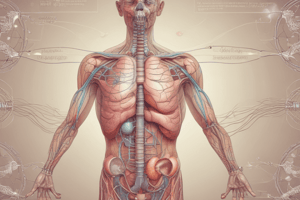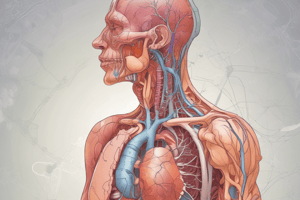Podcast
Questions and Answers
What is the total lung capacity of a human being?
What is the total lung capacity of a human being?
- 4800 mL
- 6000 mL
- 5000 mL
- 5800 mL (correct)
How much air is typically inhaled and exhaled at rest?
How much air is typically inhaled and exhaled at rest?
- 400 mL
- 300 mL
- 600 mL
- 500 mL (correct)
What percentage of oxygen in the air leads to maximum binding with hemoglobin?
What percentage of oxygen in the air leads to maximum binding with hemoglobin?
- 25%
- 30%
- 21% (correct)
- 15%
What forms when oxygen combines with hemoglobin in the lungs?
What forms when oxygen combines with hemoglobin in the lungs?
How is carbon dioxide primarily transported in the blood?
How is carbon dioxide primarily transported in the blood?
What is a major difference between hemoglobin and chlorophyll?
What is a major difference between hemoglobin and chlorophyll?
What happens to hemoglobin at high altitudes?
What happens to hemoglobin at high altitudes?
What happens to oxyhemoglobin in tissues?
What happens to oxyhemoglobin in tissues?
Study Notes
Lung Capacity
- Total lung capacity in humans is approximately 5800 mL.
- Normal inhalation and exhalation at rest is around 500 mL of air.
- After complete exhalation, about 1200 mL of air remains in the lungs.
Transportation of Gases
- Air consists of various gases that occupy the lungs and alveoli upon inhalation.
- The composition of gases in air influences their transport in the bloodstream.
- Oxygen constitutes about 21% of the air and is primarily carried by hemoglobin in red blood cells.
- Hemoglobin is a colored pigment similar to chlorophyll but contains iron (Fe) instead of magnesium.
- When oxygen diffuses into the blood, it forms oxyhemoglobin through a rapid binding process.
- Hemoglobin can release oxygen, demonstrating a reversible reaction in oxygen transport.
Carbon Dioxide Transport
- Carbon dioxide is primarily transported in the blood as bicarbonate ions.
- Some carbon dioxide binds to hemoglobin, while the remainder is dissolved in blood plasma.
Chemical Equations for Gas Exchange
- In the lungs:
- $$Hb + 4O_2 \longrightarrow Hb(O_2)_4$$
- In tissues:
- $$Hb(O_2)_4 \longrightarrow Hb + 4O_2$$
Effects of Altitude on Oxygen Transport
- Hemoglobin effectively combines with oxygen at sea level.
- At higher altitudes, oxygen concentration decreases significantly, leading to potential challenges in oxygen transport.
Studying That Suits You
Use AI to generate personalized quizzes and flashcards to suit your learning preferences.
Description
This quiz covers the basics of human lung capacity, inhalation, and exhalation, as well as the transportation of gases in the bloodstream. It's perfect for students of biology and health sciences.




